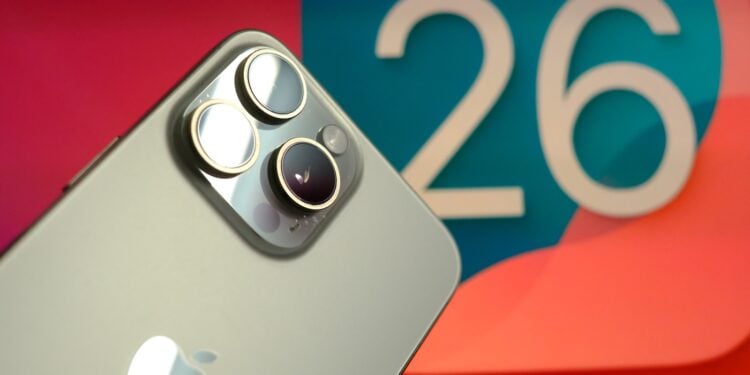With iOS 26, Apple has redesigned the Camera app – more significantly than in recent years. The update brings a new layout, a modern design with a depth effect, and clearer controls. At the same time, the app remains functionally complete, so familiar settings and modes are still available, just in a new arrangement. There are also some technical innovations, for example, regarding interaction with AirPods or for developers.
The Camera app is one of the most used features on an iPhone. Changes to its functionality are therefore particularly noticeable. Apple has addressed this issue in iOS 26: The app now appears cleaner, clearer, and less cluttered. Many elements have been rearranged or made more accessible. Despite the visual changes, all familiar functions remain. Those who previously worked with the Camera app will still find their way around – but will get a more modern and usable overall package.
Revised design with Liquid Glass
The most noticeable change is the new design. Like other apps in iOS 26, the Camera app now uses the so-called Liquid Glass design. The controls are rounder and appear to float slightly above the background due to a depth effect. The area behind the shutter button is slightly transparent, allowing a view beyond the actual image section. The zoom buttons no longer have a background bar, which obscures the image less. The button for displaying the last photo is now round, no longer square – adapted to the new design. The controls are now slightly lower on the screen, making them easier to reach with the thumb.
New layout with two main modes
The navigation bar at the bottom of the screen has been redesigned. Instead of all camera and video modes, there are now just two main categories: "Photo" and "Video." Other modes such as Portrait, Panorama, Slo-Mo, or Cinematic can still be selected using a swipe gesture—it works as usual. The buttons for zoom levels on devices with multiple lenses are still in their usual place. Switching to the front camera and accessing the most recently captured image also work unchanged. The shutter button has a more discreet design: The previously bright white ring has been replaced by a simple, liquid glass-style frame.
Pop-up menus for settings
Some controls that were previously permanently displayed are now housed in pop-up menus. These open when a mode such as "Photo" or "Video" is active and you tap the corresponding button. In Photo mode, settings for flash, Live Photo, timer, exposure, styles, aspect ratio, and Night mode appear there. If you select "Exposure," for example, a slider opens that allows you to adjust the value directly. Options are also available in Video mode, including flash, exposure, and a mode called "Action." The other modes each offer at least one option in the pop-up menu. The menu also has the new Liquid Glass design with larger buttons. It can also be opened via the menu icon in the top right of the display. Some shortcuts remain permanently visible, such as those for RAW recording, flash, or Night mode. Context-related options such as Macro mode only appear when relevant, as before.
- In the camera settings (system settings) you can specify whether certain displays such as flash, Live Photos or action mode are displayed by default.
AirPods as a remote shutter release
A new feature in iOS 26 is the ability to use AirPods Pro 2 and AirPods 4 as a remote shutter release for the camera app. Once the AirPods are connected, simply press the stem to take a photo or start a video. Pressing again stops the recording. This feature works not only with the built-in camera app, but also with third-party apps. iOS 26 and the latest firmware for the AirPods, which will be distributed with the update, are required.
Cleaning instructions for dirty lenses
Also new: The iPhone detects when the camera lens is dirty and displays a notification. This prevents images from becoming blurry due to dirt or fingerprints.
APIs for third-party apps
iOS 26 also offers new opportunities for developers. A Cinematic Mode API allows third-party apps to record videos with shallow depth of field and automatic focus shifting. This uses Rack Focus—the focus automatically shifts from one object to another, as seen in film productions. There's also an Audio Mix API. This allows audio tracks to be adjusted after recording. Third-party apps can thus offer the same audio modes as the Camera app itself:
- In-Frame reduces noise and voices outside the picture
- “Studio” reduces reverb and ambient noise
- “Cinematic” highlights voices in the foreground while ambient sounds remain spatial
iPhone camera as a magnifying glass for the Mac
iOS 26, in conjunction with macOS 26, introduces a new accessibility feature. Continuity Camera lets you use the iPhone camera live as a digital magnifying glass on your Mac. The live image appears on the Mac display and can be enlarged there. One example Apple has shown: A student with vision problems uses her iPhone to film a distant blackboard. The enlarged image is displayed on the Mac, allowing her to take notes. The camera can be zoomed in and offers the same options as in normal use.
iOS 26 makes the camera app slimmer and smarter
The Camera app in iOS 26 doesn't look completely new, but it is significantly modernized. Visual adjustments with the Liquid Glass design make the interface cleaner and less distracting. The new structure with two main modes provides more clarity without removing familiar features. Pop-up menus, AirPods as a remote shutter release, automatic cleaning detection, and new developer APIs meaningfully expand the range of functions. With iOS 26, the Camera app is not only prettier but also more versatile – for casual users and professionals alike. The best products for you: Our Amazon Storefront offers a wide selection of accessories, including those for HomeKit. (Image: Shutterstock / Ravi_Sharma1030)
- iOS 26 at a glance: What's new in the Messages app
- Apple redesigns TV app: What's new in iOS 26
- iOS 26: All the new features and highlights of the Podcasts app
- iOS 26: How Apple fundamentally changes the phone app
- iOS 26: Everything about the new home screen with Liquid Glass
- iOS 26: All the new features around the Liquid Glass design
- iOS 26: 7 exciting AirPods features at a glance
- iOS 26: Everything you need to know about the new FaceTime features
- Genmoji in iOS 26: Apple gives the feature a major update
- iOS 26: Everything about the new games app for iPhone, iPad, and Mac
- iOS 26: The most important new features in the Photos app
- iOS 26: Beats and AirPods automatically pause when you sleep
- iOS 26: All Apple Music innovations at a glance
- iOS 26 expands the functionality of the HomePod
- Image Playground gets significantly better with iOS 26
- iOS 26 brings new screenshot features to the iPhone
- iOS 26: Five new lock screen features at a glance
- iOS 26 design change: Reduce transparency easily
- iOS 26: Create your own ringtones – without GarageBand
- iOS 26: All the new features for Notes and Reminders
- Apple's new Siri could be worth the wait
FAQs about iOS 26 and the redesigned Camera app
iOS 26 brings a redesigned design with the new Liquid Glass look, a simplified layout with two main modes, and context-dependent pop-up menus.
The camera app in iOS 26 uses the Liquid Glass design with rounder buttons, a depth effect, and a partially transparent user interface.
Camera pop-up menus in iOS 26 provide quick access to settings such as flash, exposure, Live Photo, timer, aspect ratio, and night mode.
Yes, with iOS 26 you can take photos and videos with your AirPods Pro 2 or AirPods 4 by pressing the stem of the AirPods.
The remote shutter feature in iOS 26 works with AirPods Pro 2 and AirPods 4 – provided they have the latest firmware.
Yes, iOS 26 provides APIs for Cinematic Mode and Audio Mix, allowing third-party apps to leverage professional video features.
iOS 26 can detect when the camera lens is dirty and informs you via a notification so that the lens can be cleaned.
Instead of many modes, iOS 26 now offers just two main options: Photo and Video. Other modes can be accessed via a swipe gesture.
No, despite the new design, operation remains intuitive. Familiar functions are still available, but are arranged more clearly.
With iOS 26, you can use your iPhone as a digital magnifying glass for your Mac. The camera image is displayed live on your Mac via Continuity Camera.





